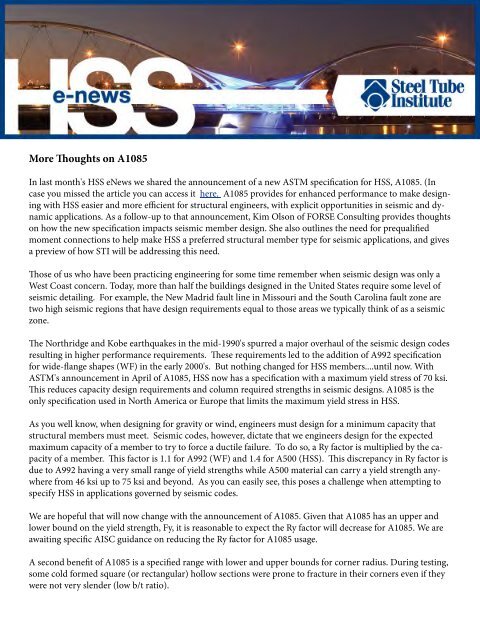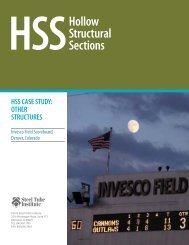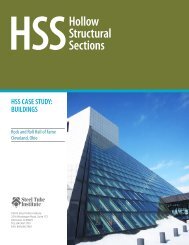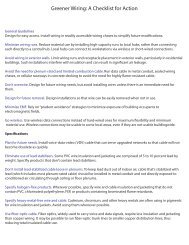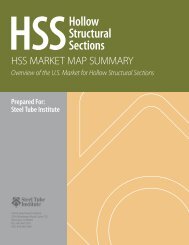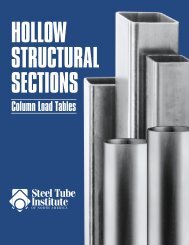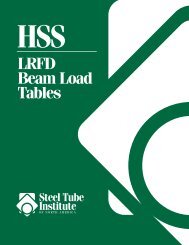read more - Steel Tube Institute
read more - Steel Tube Institute
read more - Steel Tube Institute
You also want an ePaper? Increase the reach of your titles
YUMPU automatically turns print PDFs into web optimized ePapers that Google loves.
More Thoughts on A1085<br />
In last month's HSS eNews we shared the announcement of a new ASTM specification for HSS, A1085. (In<br />
case you missed the article you can access it here. A1085 provides for enhanced performance to make designing<br />
with HSS easier and <strong>more</strong> efficient for structural engineers, with explicit opportunities in seismic and dynamic<br />
applications. As a follow-up to that announcement, Kim Olson of FORSE Consulting provides thoughts<br />
on how the new specification impacts seismic member design. She also outlines the need for prequalified<br />
moment connections to help make HSS a preferred structural member type for seismic applications, and gives<br />
a preview of how STI will be addressing this need.<br />
Those of us who have been practicing engineering for some time remember when seismic design was only a<br />
West Coast concern. Today, <strong>more</strong> than half the buildings designed in the United States require some level of<br />
seismic detailing. For example, the New Madrid fault line in Missouri and the South Carolina fault zone are<br />
two high seismic regions that have design requirements equal to those areas we typically think of as a seismic<br />
zone.<br />
The Northridge and Kobe earthquakes in the mid-1990's spurred a major overhaul of the seismic design codes<br />
resulting in higher performance requirements. These requirements led to the addition of A992 specification<br />
for wide-flange shapes (WF) in the early 2000's. But nothing changed for HSS members....until now. With<br />
ASTM's announcement in April of A1085, HSS now has a specification with a maximum yield stress of 70 ksi.<br />
This reduces capacity design requirements and column required strengths in seismic designs. A1085 is the<br />
only specification used in North America or Europe that limits the maximum yield stress in HSS.<br />
As you well know, when designing for gravity or wind, engineers must design for a minimum capacity that<br />
structural members must meet. Seismic codes, however, dictate that we engineers design for the expected<br />
maximum capacity of a member to try to force a ductile failure. To do so, a Ry factor is multiplied by the capacity<br />
of a member. This factor is 1.1 for A992 (WF) and 1.4 for A500 (HSS). This discrepancy in Ry factor is<br />
due to A992 having a very small range of yield strengths while A500 material can carry a yield strength anywhere<br />
from 46 ksi up to 75 ksi and beyond. As you can easily see, this poses a challenge when attempting to<br />
specify HSS in applications governed by seismic codes.<br />
We are hopeful that will now change with the announcement of A1085. Given that A1085 has an upper and<br />
lower bound on the yield strength, Fy, it is reasonable to expect the Ry factor will decrease for A1085. We are<br />
awaiting specific AISC guidance on reducing the Ry factor for A1085 usage.<br />
A second benefit of A1085 is a specified range with lower and upper bounds for corner radius. During testing,<br />
some cold formed square (or rectangular) hollow sections were prone to fracture in their corners even if they<br />
were not very slender (low b/t ratio).
This has resulted in engineers shying away from specifying square hollow sections as bracing in lieu of pipe or<br />
WF sections which produce a <strong>more</strong> desirable gradual buckling deformation. The new material, plus the specification<br />
of a minimum corner radius, will work to minimize these fractures.<br />
A1085 will obviously improve ease of use of HSS for structural members. But what about the impact on connection<br />
design One area of explicit need is prequalified moment connections for HSS now that A1085 has<br />
been released. Because of the past design challenges surrounding A500 as a true option for moment frames,<br />
moment connections for HSS have never been fully scoped. Now that A1085 will be a viable option for seismic<br />
and dynamic applications, documentation of moment connections to resist seismic loads is an obvious need.<br />
We at STI realize the lack of such documentation and know it is vital to aid in the adoption of A1085. In coming<br />
months, a number of us who serve as technical advisors to STI will be working with connection experts<br />
in the industry to meet this need. Be looking for a Part II to this article providing you with an update on our<br />
progress come late summer or early fall.<br />
Until then, we encourage engineers to continue learning about A1085 by monitoring news from STI and<br />
AISC. Should you have questions you’d like addressed in future issues of HSS eNews -- or to inquire about<br />
using A1085 in a specific design or application -- feel free to connect with us via email at<br />
hssinfo@steeltubeinstitute.org.


